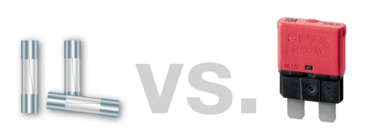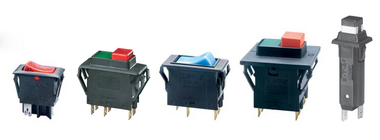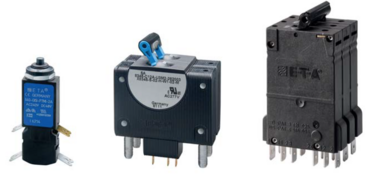Fuse vs. circuit breaker: How to choose the right device for your application

Is a fuse or circuit breaker best for your design? Here are some pointers to help you decide.
Three main factors go into choosing between circuit breakers and fuses: Convenience for the user, cost, and degree of protection. While some of these may seem obvious, they're not, and the answers vary depending on the application.
Convenience for the user
Obviously, it's easier to reset a breaker than it is to replace a fuse. There's nothing to buy and keep in stock. There's nothing to get lost. And while the initial cost of a fuse is usually less than a breaker, on circuits subject to frequent overloads the cost of replacement fuses can begin to add up—not to mention the inconvenience.
Degree of protection
When a breaker trips the user only has one way to turn the power back on: reset the breaker. With fuses, it’s another matter. Users have been known to replace a blown fuse with whatever they have on hand, or worse.
There are two versions of "worse." The first is that a user, tired of repeatedly replacing the same fuse, installs one with a higher rating than the original. The 5-A fuse blows all the time... We'll put in a 10 A fuse. No more blown fuses.
This often happens when a user replaces a delay-type fuse with a non-delay one in an application with heavy starting surges—motor starting, for example. A motor that draws several times normal current when starting may blow a non-delay fuse. If the user replaces it with the proper time-delay fuse, the nuisance tripping will stop, but if he instead replaces it with another non-delay fuse it will blow again, and so on until someone puts in a too-heavy fuse. This stops the nuisance blowing, but removes protection. If a real overload occurs, the replacement fuse may not blow at all, and the equipment can be damaged or destroyed. It may even start a fire.
When designing a fuse into a piece of equipment it is a good idea to put a label on the panel next to the fuse holder that indicates the type of fuse required; otherwise when a fuse blows the user will have no guidance on how to replace it except for what was there before—which may or may not be the fuse specified by the manufacturer. The alternative is to depend on the user to read and remember what is in the equipment manual..
There have even been cases when users have shorted out fuseholders to get equipment back in operation, such as wrapping aluminum foil around a blown tubular fuse and reinserting it, or just using a piece of metal to complete the circuit. The equivalent of putting a penny behind a fuse in the house, this removes all protection. A circuit breaker can’t be bypassed like this, and if it has a trip-free mechanism it can’t be held closed manually against an overload.
Fuses also can die of old age, even without an overload. As equipment is turned on and off repeatedly, the fuse link undergoes heat cycling which can cause subtle metallurgical changes that eventually cause it to fail in normal operation. This effect is accelerated by vibration. In addition, if the fuseholder corrodes or its grip on the fuse loosens the resistance between it and the fuse will increase. This can cause the fuse to run hot, which heats the fuseholder and causes its tension to decrease still more, again leading to premature failure. In all of these cases the user has to replace the fuse, with all the potential dangers of putting in the wrong type, and if the fuseholder has lost its grip it too must be replaced, which means opening up the equipment.
The bottom line is equipment manufacturers have no control over what fuse the user puts in, but may still be held liable for the result.
A properly specified breaker is designed to trip only if there is an actual overload. If the overload persists it will trip again, but it's unlikely that someone would remove the breaker and put in one rated for more current. The user is more likely to correct the problem that caused the breaker to trip in the first place, and the equipment manufacturer maintains control of the equipment protection situation.
Ancillary Circuit Breaker Features
Both fuses and breakers provide protection, but breakers are available with additional functionality, including the ability to act as an on-off switch, auxiliary contacts, manual operation, shunt terminals, dual control (remote or relay trip) and undervoltage release.

A breaker rated for use as a manual switch eliminates the need for an on/off switch. Just be sure to choose one rated for this service. Under European standard EN 60934 S-type breakers can be used as an on/off switches, while M-type can be used to manually disconnect occasionally, but not for normal on/off duty.
Multipole circuit breakers - In the event of a failure, multipole circuit breakers always ensure all-pole breaking. Quite the contrary is the case with fuses. If both the phase and the neutral conductor are protected by a fuse in a single-phase AC device on the input side, normally only one of the fuses will trip in the event of a failure due to tolerances. If the fuse of the neutral conductor blows, the device or the machine is still energized. Repair works puts the maintenance workers at risk of electrical shock!

Auxiliary contacts —also called an auxiliary switch—are used to alert an operator or a control system, sound an alarm, or even switch on backup power sources in critical applications. A variation on this is a shunt terminal, which taps off between the contacts and the current sensing element, so it's switched by the main contacts but is unprotected. Unlike the auxiliary contact, it's connected to the breaker's current-carrying path. It's useful for shutting down a second piece of equipment if the breaker trips. It can also be used for calibrating sensing elements, and for that reason is sometimes called a calibrating tap.
Dual control (also called remote trip or relay trip) breakers combine two electrically separate sensing elements to provide, for example, conventional overcurrent protection plus disconnection by means of a remote actuator or sensor. Remote trip is sometimes referred to as relay trip. This arrangement can become fairly elaborate.
Undervoltage release is a separate voltage-sensitive actuator inside the circuit breaker that causes the main contacts to open when the voltage falls below a predetermined value. S-type circuit breakers with undervoltage release are widely specified as ON/OFF controls for cord-connected appliances which are required by safety legislation to return to the OFF position if electrical power is removed—by unplugging for example. This avoids the danger of an appliance re-starting unexpectedly if power is restored with the switch in the ON position.
High-temperature derating
High temperatures can make circuit protection devices operate at lower-than-normal currents, and shorten the delays of delay-type devices. For example, at 60ºC (140ºF) a typical dual-element fuse will open at about 87 percent of its 25ºC current, and its delay will decrease to about 70 percent of its room-temperature value. A typical thermal breaker will derate by a similar amount. This may or may not be a problem. Motors, for example, tend to draw smaller starting surges when they are warm, so a shortened delay does not cause any difficulty. In addition, equipment that is hotter is more sensitive to overloads, so reducing the operating current for the protective device can be beneficial.
There are applications where circuit breakers must operate continuously at either high or low temperatures that are different from that of the equipment being protected (aircraft as an example). If a regular thermal breaker is used, follow the manufacturer’s guidelines for derating. For example, when an application calls for 10A protection with a thermal breaker that will be at 50ºC, the breaker should have a room-temperature rating of 12 A.
If the carry current of the protective device cannot change with temperature, there are two answers. One is a temperature compensated thermal breaker, where the time/current characteristics will not change significantly over a defined temperature range. The other is a magnetic breaker, which is virtually insensitive to temperature. If the circuit has surges and requires a protective device with a delay function, a hydraulic-magnetic breaker can do the job. The delay will decrease slightly at elevated temperatures (because the viscosity of the hydraulic fluid in the delay mechanism decreases slightly with increasing temperature) but the carry current will remain the same.
Limiting fault currents
One area in which designing protection becomes tricky is when it’s necessary to limit fault currents—for example, in the load circuit of a solid state relay (SSR) or other semiconductor device. These circuits might require a protective device to open the circuit before the semiconductor device is damaged. Traditionally, this has required a high-speed fuse with a carefully-chosen I2T rating, where I2T, the square of the current that gets though the protective device times the time it takes to open, provides a measure of the total heat dissipated by the semiconductor before the protective device clears the fault.. Many solid sate relays have I2T withstand ratings, and choosing a fuse with a lower I2T rating will help ensure that it is protected.
Fuses are not the only protective devices that can limit current. Some fast-acting magnetic breakers can open in 2 ms or less, which is well before an AC waveform can reach the peak of the cycle, and hence will limit the peak let-through current. For lower-voltage DC applications there are now smart circuit protectors that electronically limit fault current before they open, keeping peak currents down to a safe range and preventing damage.
Current ratings
The current rating for a circuit breaker and the ampere rating of a fuse are not specified the same way. The ampere rating of a fuse is the current where it will eventually blow, and for this reason the ampere rating of a fuse is generally specified as 125% of the normal load current. In contrast, the current rating of a breaker is the current it can carry indefinitely without tripping. For this reason, it is standard practice to set the current rating of a breaker equal to the normal load current.
Voltage ratings
Choosing the wrong voltage rating for a protective device—whether it be a fuse or a circuit breaker—can seem like a subtle error, because it doesn’t cause a problem until there is an overload. When a fuse or breaker not rated for the system voltage operates, the result is often a destructive arc, which can damage or destroy equipment and even cause a thermal event.
Some multi-pole breakers have two voltage ratings, like 480/277 volts. The first number is the line-to-line rating and the second the line-to-neutral rating. Under certain conditions, the breaker may experience the line-to-line voltage across what should be a line-to-neutral, which can cause problems. It is almost always best to err on the side of higher voltage rating. DC voltage ratings are generally lower than AC ratings for both breakers and fuses. This is because a DC arc, which does not go to zero current 120 times per second, is more difficult to extinguish than an AC arc.
Delay characteristics
Both fuses and circuit breakers are available with a variety of time delay characteristics. A fuse with a single element will trip quickly when its rating is exceeded. Time-delay fuses have elements with extra metal added to increase their thermal mass. The heavy element heats up slowly, helping to prevent blowing on momentary overloads. Dual-element fuses incorporate a second element in series with the delay element that will blow instantly under short circuit conditions.
Thermal circuit breakers, because of their thermal mass, provide a time-delay characteristic useful in applications with high inrush currents or frequent momentary overloads. The greater the overload the faster the trip—a typical thermal breaker will hold a 2x overload for 8 to 40 seconds, yet trip in 1 to 2 seconds on a 10x overload. In applications where both time delay on normal overloads and instantaneous tripping on short circuits is required a good choice is a thermal-magnetic breaker, which has both a thermal element with a conventional delay and a magnetic coil that will open the circuit in 10 ms or less on a 10x or greater overcurrent.
For high-speed operation, there are magnetic breakers, which have no thermal element and can trip in a few tens of milliseconds on a 2x overload. When a time delay is needed, there are magnetic-hydraulic breakers, where the magnetic coil has a metal core that moves through a tube filled with hydraulic fluid under overload conditions but will trip instantaneously under a short circuit.
One may wonder why there are both thermal-magnetic and a magnetic-hydraulic breakers, when they appear to do the same thing. The main reason is that a thermal breaker, unless specially compensated, changes its trip point with ambient temperature, and a magnetic breaker does not. Whether this is an advantage depends on the application—the thermal breaker’s change in tripping level with temperature tends to track the protection needs of the equipment it’s protecting. In addition, thermal breakers are less sensitive to shock and vibration than magnetic breakers, they don’t care about mounting orientation (magnetic breakers must be derated if they’re not mounted right side up on a vertical surface) and they cost less than magnetic breakers for the same protection.
Single-phase failures on three-phase circuits
A three-phase circuit can be protected against overcurrent with either a three-phase circuit breaker (which is essentially three circuit breakers mechanically ganged together) or three fuses. If there is an overcurrent on just one phase, the circuit breaker element on that phase will trip and mechanically trip the other two phases. If there are fuses, the fuse on the affected phase will open. If the load is a motor, the current on the other two phases will increase, and if everything goes just right, the fuses on the other two phases should, after a delay, trip as well. If everything does not go just right, of course, the equipment may continue to try to run with one phase missing.
Interrupting ratings
The interrupting rating of a protective device is the fault current (generally caused by a short circuit) that the device can interrupt safely (without exploding or causing a thermal event). The amount of potential fault current to which such a device can be exposed depends on the system voltage and the resistance of the wiring upstream of the device. If an electrical outlet is just 20 feet away from the power source and it is wired with AWG 14 copper wire the maximum available fault current at the outlet can be no more than 1200A at 120V. This is in contrast to the available fault current in a service panel, which can reach tens of kiloamperes.
The table shows the effect of different lengths of wire on the amount of short-circuit current available.
| Voltage | 120V | 240V | ||
| Distance, ft/AWG | 14 | 12 | 14 | 12 |
| 20 | 1188 | 1889 | 2377 | 3778 |
| 100 | 237 | 377 | 475 | 755 |
Table: Short-circuit currents for various distances, voltages and wire gauges
After calculating the maximum fault current exposure that a protective device can handle it would seem that selecting a device with the appropriate interrupting rating would be simple. In the case of a fuse, it is: its interrupting rating should be listed in the catalog.
Interrupting ratings for circuit breakers are a little more complicated and the major difference is what happens to the circuit breaker after it has broken the fault current. Whether mentioned on the data sheet or not, every breaker has two ratings for interrupting capacity. One specifies the amount of current the breaker can interrupt safely and still work afterwards (sometimes referred to as Icn). The other (generally much higher) rating specifies the largest current that the breaker can interrupt safely (i.e., without causing a thermal event) but may be destroyed in the process ("not fit for further use" or "not recalibrated after testing"). Some manufacturers publish both ratings, but many do not. It may be necessary to contact the manufacturer for clarification.
The rating to use depends on the maximum possible current available at the point of use. If frequent shorts are expected, it's a good idea to specify a breaker that will survive, and be “fit for further use.” If the breaker's main job is to protect against overloads, and shorts are infrequent or limited by other circuit components, then it’s less important that the breaker survive such an event.